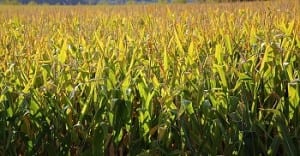Wind turbine energy may be improved by soybeans
December 29, 2014Crops planted below turbines may have an effect on wind energy production.
Researchers, who attended the annual meeting of the American Geophysical Union in San Francisco, explained how they believe that crops that are planted below turbines have an effect on wind turbine energy generation, and that certain tall crops, like corn, can slow down wind compared to shorter crops, like soybeans, which can boost power, reported Inside Science.
At the height of the turbines there could be up to a 3% difference in wind speed.
According to a University of Colorado Boulder grad student in atmospheric science, Brian Vanderwende, depending on the crops that are below a turbine, there may be up to a 3% difference in the speed of the wind at the height of the turbines and a 14% increase in wind power production.
Several factors can influence the amount of power that a wind turbine generates. How each one interacts with the wind and how much power it produces is affected by how the turbines are arranged and wind speed changes. However, researchers are finding that what is planted below these massive structures may also be influencing their ability to generate power.
In terms of the role that crops play, the research examined the difference in wind energy generation over a range of wind mills that were grouped in an 11×11 grid that consisted of 121 turbines. These turbines typically produced 250 MW (megawatts) of electricity.
After the harvest, the effect on wind turbine energy production disappears.
 Iowa produces both corn and soybean crops. What researchers discovered was that by midsummer, Corn stands at about a height of eight feet. Its combined height and the pattern in which the crop is planted, creates a notably large degree of roughness, and this rough ground imparts drag on the wind, which can slow it down. Soybean plants, on the other hand, generally grow to half the size of corn. As a result, they create less roughness, which means less drag to slow the wind.
Iowa produces both corn and soybean crops. What researchers discovered was that by midsummer, Corn stands at about a height of eight feet. Its combined height and the pattern in which the crop is planted, creates a notably large degree of roughness, and this rough ground imparts drag on the wind, which can slow it down. Soybean plants, on the other hand, generally grow to half the size of corn. As a result, they create less roughness, which means less drag to slow the wind.
In addition, the researchers found that the effects on wind power that they noted in August, when the crops were at their full maturity, was no longer an issue after the harvest and that in the earlier part of the growing season, the difference was less.
Although there are several factors that can effect wind turbine energy generation, Mark Jacobson, a Stanford University in California atmospheric scientist, said that the research findings regarding crops could help farmers make better choices before selecting what to plant. Jacobson said that “All that information helps people make better decisions.”

 With over 15 years of reporting hydrogen news, we are your premier source for the latest updates and insights in hydrogen and renewable energy.
With over 15 years of reporting hydrogen news, we are your premier source for the latest updates and insights in hydrogen and renewable energy.